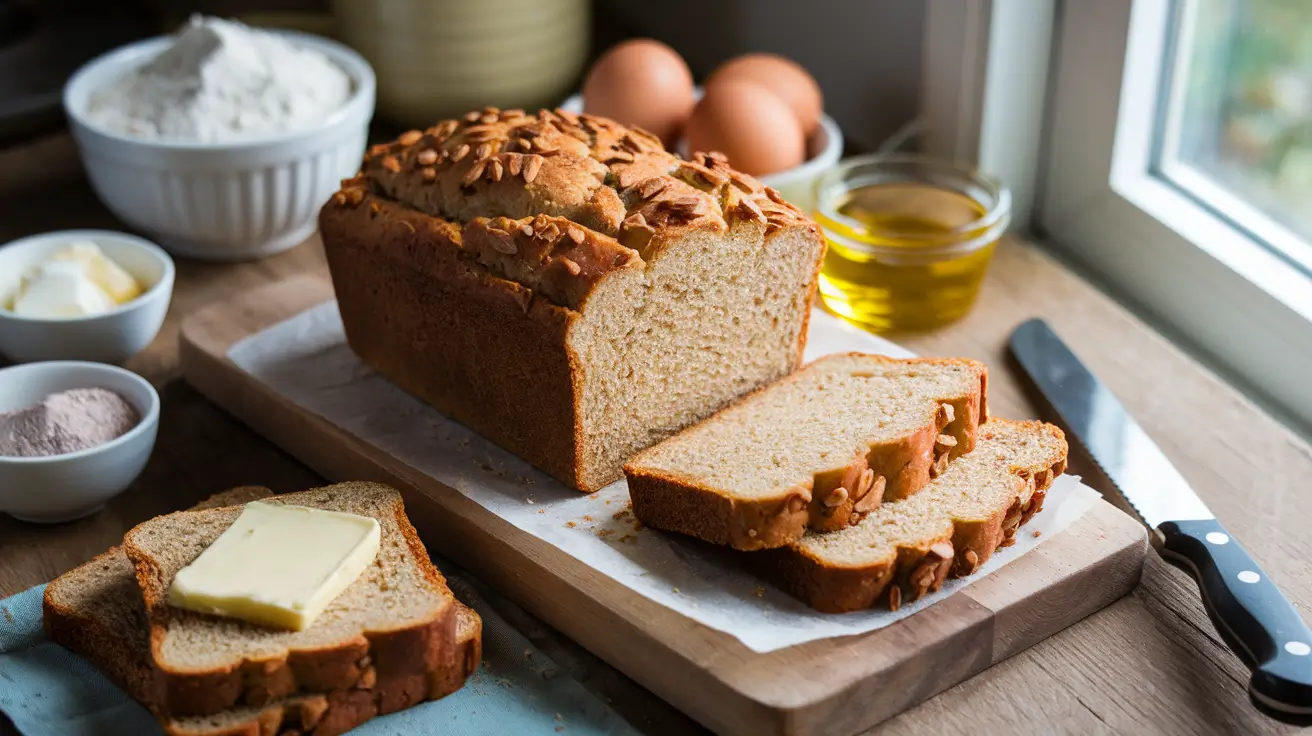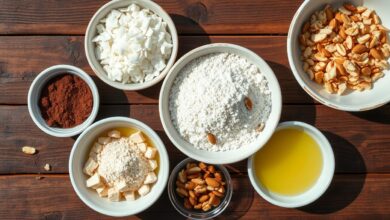The Ultimate Guide to Keto Bread: Recipes, Tips, and Tricks

Table of Contents
- Introduction
- Understanding Keto Bread
- Essential Ingredients for Keto Bread
- Basic Keto Bread Recipe
- Variations of Keto Bread
- Tips for Perfect Keto Bread
- Troubleshooting Common Issues
- Storing and Freezing Keto Bread
- Nutritional Information and Benefits
- Frequently Asked Questions
- Conclusion
Introduction
Are you following a ketogenic diet but missing the comfort of a warm, freshly baked slice of bread? You’re not alone. Many people on the keto diet find themselves craving the texture and versatility of bread. The good news is that with the right ingredients and techniques, you can enjoy delicious, low-carb bread that fits perfectly into your keto lifestyle.
In this comprehensive guide, we’ll explore everything you need to know about keto bread. From understanding what makes bread keto-friendly to mastering various recipes and troubleshooting common issues, we’ve got you covered. Whether you’re a seasoned keto dieter or just starting out, this post will equip you with the knowledge and skills to bake perfect keto bread every time.
Understanding Keto Bread
Before we dive into recipes and techniques, it’s essential to understand what sets keto bread apart from traditional bread. Keto bread is designed to be low in carbohydrates and high in fat, aligning with the principles of the ketogenic diet. This diet typically requires keeping carb intake below 50 grams per day to maintain a state of ketosis, where the body burns fat for fuel instead of carbohydrates.
Key characteristics of keto bread include:
- Low Carb Content: Unlike regular bread, which can contain 20-30 grams of carbs per slice, keto bread typically has less than 5 grams per slice.
- High Fat Content: Keto bread often incorporates ingredients high in healthy fats, such as nuts, seeds, and oils.
- Moderate Protein: While not as high in protein as some other keto foods, keto bread often contains more protein than traditional bread due to ingredients like eggs and nut flours.
- Fiber-Rich: Many keto bread recipes use high-fiber ingredients, which can help with digestion and feeling full.
- Gluten-Free: Most keto bread recipes are naturally gluten-free, as they don’t use wheat flour.
Understanding these principles will help you appreciate the ingredients and techniques used in keto bread recipes, and even experiment with creating your own variations.
Essential Ingredients for Keto Bread
The key to successful keto bread lies in choosing the right ingredients. Here are some staples you’ll often find in keto bread recipes:
- Almond Flour: A popular base for keto bread, almond flour is low in carbs and high in healthy fats and protein. It provides a moist texture and nutty flavor.
- Coconut Flour: Another low-carb flour option, coconut flour is highly absorbent and requires more liquid in recipes. It adds a slight sweetness to bread.
- Psyllium Husk: This fiber-rich ingredient helps bind the bread and improve its texture, making it more similar to traditional bread.
- Eggs: Eggs act as a binder and provide structure to keto bread. They also add protein and healthy fats.
- Baking Powder: This leavening agent helps the bread rise and achieve a lighter texture.
- Xanthan Gum: Often used in gluten-free baking, xanthan gum helps improve the texture and structure of keto bread.
- Healthy Oils: Ingredients like olive oil, coconut oil, or avocado oil add moisture and healthy fats to the bread.
- Seeds: Chia seeds, flaxseeds, or sunflower seeds can add texture, flavor, and additional nutrients to keto bread.
By familiarizing yourself with these ingredients, you’ll be better equipped to understand keto bread recipes and even experiment with creating your own variations.
Basic Keto Bread Recipe
Now that we understand the principles and ingredients of keto bread, let’s start with a basic recipe that you can master and then build upon. This simple almond flour keto bread is a great starting point for your keto baking journey.
Ingredients:
- 2 1/2 cups almond flour
- 1/4 cup psyllium husk powder
- 1 tablespoon baking powder
- 1/2 teaspoon salt
- 4 large eggs
- 1/4 cup olive oil
- 1/2 cup warm water
- 1 tablespoon apple cider vinegar
Instructions:
- Preheat your oven to 350°F (175°C). Line a loaf pan with parchment paper.
- In a large bowl, whisk together the almond flour, psyllium husk powder, baking powder, and salt.
- In a separate bowl, beat the eggs, then add the olive oil, warm water, and apple cider vinegar. Mix well.
- Pour the wet ingredients into the dry ingredients and stir until well combined. The mixture will thicken as you stir.
- Transfer the batter to the prepared loaf pan and smooth the top with a spatula.
- Bake for 55-65 minutes, or until a toothpick inserted into the center comes out clean.
- Allow the bread to cool in the pan for 10 minutes, then remove and cool completely on a wire rack before slicing.
This basic recipe yields a loaf that’s perfect for sandwiches, toast, or simply enjoying with some butter. It’s a versatile base that you can customize with herbs, spices, or seeds to suit your taste preferences.
Variations of Keto Bread
Once you’ve mastered the basic keto bread recipe, you might want to explore some variations to keep things interesting. Here are three popular alternatives:
Coconut Flour Keto Bread
Coconut flour is another excellent low-carb option for keto bread. It has a slightly sweet flavor and is highly absorbent, requiring more eggs and liquid in the recipe.
Ingredients:
- 3/4 cup coconut flour
- 6 large eggs
- 1/2 cup coconut oil, melted
- 1/2 cup warm water
- 1 tablespoon baking powder
- 1/4 teaspoon salt
- 1 teaspoon xanthan gum (optional, for improved texture)
Instructions:
- Preheat your oven to 350°F (175°C) and line a loaf pan with parchment paper.
- In a large bowl, whisk together the coconut flour, baking powder, salt, and xanthan gum (if using).
- In a separate bowl, beat the eggs, then add the melted coconut oil and warm water. Mix well.
- Combine the wet and dry ingredients, stirring until a thick batter forms.
- Pour the batter into the prepared loaf pan and smooth the top.
- Bake for 40-50 minutes, or until golden brown and a toothpick inserted into the center comes out clean.
- Cool in the pan for 10 minutes before removing and cooling completely on a wire rack.
Flaxseed Keto Bread
Flaxseed bread is not only keto-friendly but also packed with omega-3 fatty acids and fiber. It has a nutty flavor and dense texture.
Ingredients:
- 2 cups ground flaxseed
- 5 large eggs
- 1/2 cup water
- 3 tablespoons olive oil
- 1 tablespoon baking powder
- 1 teaspoon salt
- 1 tablespoon dried herbs (optional, try rosemary or thyme)
Instructions:
- Preheat your oven to 350°F (175°C) and line a loaf pan with parchment paper.
- In a large bowl, mix the ground flaxseed, baking powder, salt, and dried herbs (if using).
- In another bowl, whisk together the eggs, water, and olive oil.
- Combine the wet and dry ingredients, stirring until well mixed.
- Pour the batter into the prepared loaf pan and smooth the top.
- Bake for 50-60 minutes, or until the top is golden brown and a toothpick inserted into the center comes out clean.
- Allow to cool in the pan for 10 minutes before removing and cooling completely on a wire rack.
Cheese and Herb Keto Bread
For a savory twist, try this cheese and herb keto bread. It’s perfect for serving alongside soups or using as a base for keto-friendly garlic bread.
Ingredients:
- 1 1/2 cups almond flour
- 1/4 cup coconut flour
- 2 teaspoons baking powder
- 1/2 teaspoon salt
- 1/4 cup butter, melted
- 4 large eggs
- 1/4 cup sour cream
- 1 cup shredded cheddar cheese
- 2 tablespoons chopped fresh herbs (such as chives, rosemary, or thyme)
Instructions:
- Preheat your oven to 350°F (175°C) and line a loaf pan with parchment paper.
- In a large bowl, whisk together the almond flour, coconut flour, baking powder, and salt.
- In another bowl, mix the melted butter, eggs, and sour cream.
- Combine the wet and dry ingredients, then fold in the shredded cheese and chopped herbs.
- Transfer the batter to the prepared loaf pan and smooth the top.
- Bake for 45-55 minutes, or until golden brown and a toothpick inserted into the center comes out clean.
- Cool in the pan for 10 minutes before removing and cooling completely on a wire rack.
These variations demonstrate the versatility of keto bread. Feel free to experiment with different flours, cheeses, and herbs to create your own unique flavors.
Tips for Perfect Keto Bread
Baking keto bread can be a bit tricky at first, but with these tips, you’ll be on your way to perfect loaves every time:
- Measure Accurately: Keto flours behave differently than wheat flour, so precise measurements are crucial. Consider using a kitchen scale for best results.
- Don’t Overmix: Mix your ingredients just until combined. Overmixing can lead to a dense, heavy bread.
- Use Room Temperature Ingredients: This helps ensure even mixing and consistent texture.
- Let the Batter Rest: Allowing your batter to rest for 5-10 minutes before baking can help the flours absorb the liquids, resulting in a better texture.
- Watch the Baking Time: Keto breads often bake faster than traditional breads. Start checking for doneness a few minutes before the recipe suggests.
- Cool Completely: Resist the urge to slice your bread right away. Letting it cool completely helps it set and improves the texture.
- Experiment with Add-ins: Seeds, nuts, or dried herbs can add flavor and texture to your bread.
- Use a Food Processor: For some recipes, using a food processor can help achieve a finer, more even texture in your batter.
- Don’t Skimp on Fat: Remember, keto is a high-fat diet. Using ingredients like butter or olive oil can improve the flavor and texture of your bread.
- Consider Altitude: If you live at high altitude, you may need to adjust your recipes slightly. Generally, this means adding a bit more liquid and reducing leavening agents.
Troubleshooting Common Issues
Even with the best recipes and techniques, you might encounter some challenges when baking keto bread. Here are some common issues and how to resolve them:
- Bread is too dense:
- Solution: Make sure you’re not overmixing the batter. Also, check that your baking powder is fresh and active.
- Bread is too moist in the center:
- Solution: Increase baking time, or reduce the amount of liquid in the recipe slightly.
- Bread falls apart easily:
- Solution: Try adding a binding agent like xanthan gum or an extra egg to your recipe.
- Bread has a strong eggy taste:
- Solution: Use fewer whole eggs and more egg whites, or try incorporating stronger flavors like herbs or cheese into your bread.
- Bread doesn’t rise well:
- Solution: Ensure your baking powder is fresh. You can also try adding a bit of apple cider vinegar to your recipe, which can help activate the baking powder.
- Bread has a gritty texture:
- Solution: Use finely ground almond flour or try sifting your flours before use.
- Bread sticks to the pan:
- Solution: Always line your pan with parchment paper, or use a well-greased silicone loaf pan.
Remember, keto baking often requires some experimentation. Don’t be discouraged if your first attempts aren’t perfect – with practice, you’ll develop a feel for the right textures and techniques.
Storing and Freezing Keto Bread
Proper storage is key to maintaining the quality of your keto bread. Here are some tips:
- Room Temperature Storage: Keto bread can be stored at room temperature for 2-3 days. Wrap it tightly in plastic wrap or store in an airtight container.
- Refrigeration: For longer storage, keep your bread in the refrigerator for up to a week. Always wrap it well to prevent drying out.
- Freezing: Keto bread freezes well. Slice the bread before freezing for easy portioning. Wrap individual slices or the whole loaf in plastic wrap, then place in a freezer bag. It can be frozen for up to 3 months.
- Thawing: Thaw frozen bread in the refrigerator overnight, or at room temperature for a few hours. You can also toast frozen slices directly from the freezer.
- Refreshing: To refresh slightly stale bread, toast it or warm it in the oven for a few minutes.
By following these storage tips, you can bake larger batches of bread and always have some on hand for quick meals and snacks.
Nutritional Information and Benefits
Keto bread can be a valuable addition to a ketogenic diet. Here’s a general nutritional breakdown for a typical slice of keto bread (note that this can vary depending on the specific recipe):
- Calories: 90-120
- Total Fat: 7-10g
- Total Carbohydrates: 2-4g
- Dietary Fiber: 1-2g
- Net Carbs: 1-2g
- Protein: 4-6g
Benefits of incorporating keto bread into your diet include:
- Low Carb Content: Helps maintain ketosis and supports weight loss goals.
- High in Healthy Fats: Provides sustained energy and supports hormone production.
- Nutrient-Dense: Often contains nuts and seeds, which are rich in vitamins and minerals.
- High in Fiber: Supports digestive health and helps you feel full.
- Gluten-Free: Suitable for those with gluten sensitivities or celiac disease.
- Versatile: Can be used in various ways, helping to add variety to a keto diet.
- Blood Sugar Control: The low carb content helps prevent spikes in blood sugar levels.
- Ketosis Support: By providing a bread alternative with minimal carbs, it helps maintain ketosis.
- Remember, while keto bread can be a great addition to your diet, it’s still important to consume it in moderation as part of a balanced ketogenic eating plan.
- Frequently Asked Questions
- To help you navigate the world of keto bread, here are answers to some commonly asked questions:
- Q: Can I use regular flour in keto bread recipes?
A: No, regular wheat flour is high in carbohydrates and not suitable for keto diets. Stick to low-carb flours like almond or coconut flour. - Q: Why is my keto bread purple?
A: If you’re using psyllium husk in your recipe, it can sometimes turn the bread slightly purple. This is harmless and doesn’t affect the taste. - Q: Can I make keto bread in a bread machine?
A: While it’s possible, most bread machines are designed for wheat-based breads. You may need to experiment with settings and ingredients to get good results. - Q: Is keto bread suitable for diabetics?
A: Generally, yes. The low carb content of keto bread makes it a good option for managing blood sugar levels. However, always consult with a healthcare professional for personalized advice. - Q: Can I toast keto bread?
A: Yes, most keto breads toast well. However, they may toast faster than regular bread, so keep an eye on it to prevent burning. - Q: How can I make my keto bread rise more?
A: Ensure your baking powder is fresh, consider adding a bit of apple cider vinegar to activate it, and try whipping your egg whites separately before folding them into the batter. - Q: Is keto bread paleo-friendly?
A: Some keto bread recipes can be paleo-friendly, especially those using only nut flours and eggs. However, ingredients like dairy and artificial sweeteners are common in keto recipes but not allowed on paleo diets. - Q: Can I use egg replacers in keto bread recipes?
A: While possible, it can be challenging. Eggs play a crucial role in binding and leavening keto breads. If you need to avoid eggs, look for recipes specifically designed to be egg-free. - Q: Why is my keto bread dry?
A: This could be due to overbaking or not using enough fat in the recipe. Try reducing baking time slightly or adding a bit more oil or butter to your recipe. - Q: Can I make keto burger buns or rolls?
A: Absolutely! Many keto bread recipes can be adapted to make buns or rolls. Simply shape the dough into smaller portions before baking.
Conclusion
Embarking on a ketogenic diet doesn’t mean you have to give up the comfort and versatility of bread. With the right ingredients, techniques, and a bit of practice, you can create delicious keto-friendly breads that support your low-carb lifestyle.
From the basic almond flour recipe to creative variations like cheese and herb bread, there’s a world of keto bread options to explore. Remember to pay attention to your ingredients, measure accurately, and don’t be afraid to experiment with different flavors and add-ins.
Keto bread can be a valuable tool in your ketogenic journey, providing a familiar vehicle for sandwiches, a side for soups, or simply a comforting snack. It’s rich in healthy fats and fiber, low in carbs, and can be adapted to suit various tastes and dietary needs.
As with any dietary change, it’s always a good idea to consult with a healthcare professional or nutritionist, especially if you have specific health concerns or goals. They can provide personalized advice on how to incorporate keto bread into your diet effectively.
Whether you’re a seasoned keto dieter or just starting out, we hope this guide has provided you with the knowledge and inspiration to start baking your own delicious keto bread. Happy baking, and enjoy your low-carb, high-flavor bread creations!
Remember, the key to success with keto bread (and the keto diet in general) is patience and persistence. Your first loaf might not be perfect, but with practice, you’ll soon be baking keto bread that rivals any traditional loaf. So preheat that oven, grab your almond flour, and let’s get baking!




